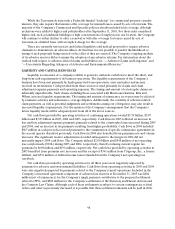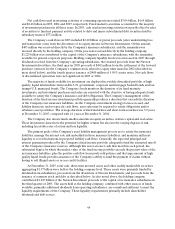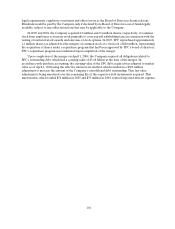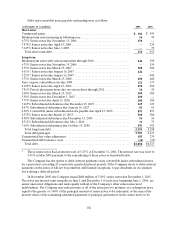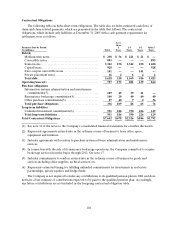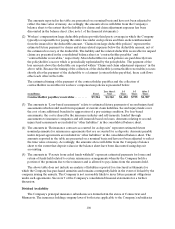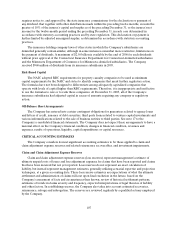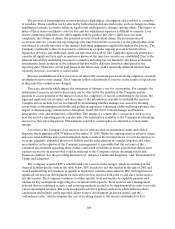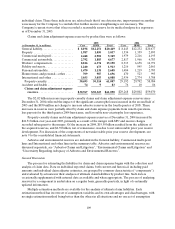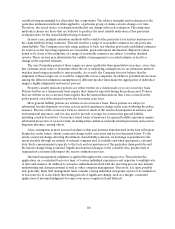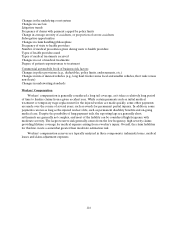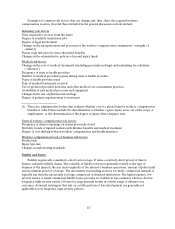Travelers 2005 Annual Report Download - page 120
Download and view the complete annual report
Please find page 120 of the 2005 Travelers annual report below. You can navigate through the pages in the report by either clicking on the pages listed below, or by using the keyword search tool below to find specific information within the annual report.108
The process of estimating loss reserves involves a high degree of judgment and is subject to a number
of variables. These variables can be affected by both internal and external events, such as changes in claims
handling procedures, economic inflation, legal trends and legislative changes, among others. The impact of
many of these items on ultimate costs for loss and loss adjustment expenses is difficult to estimate. Loss
reserve estimation difficulties also differ significantly by product line due to differences in claim
complexity, the volume of claims, the potential severity of individual claims, the determination of
occurrence date for a claim and reporting lags (the time between the occurrence of the policyholder event
and when it is actually reported to the insurer). Informed judgment is applied throughout the process. The
Company continually refines its loss reserve estimates in a regular ongoing process as historical loss
experience develops and additional claims are reported and settled. The Company rigorously attempts to
consider all significant facts and circumstances known at the time loss reserves are established. Due to the
inherent uncertainty underlying loss reserve estimates including but not limited to the future settlement
environment, final resolution of the estimated liability will be different from that anticipated at the
reporting date. Therefore, actual paid losses in the future may yield a materially different amount than
currently reserved—favorable or unfavorable.
Because establishment of loss reserves is an inherently uncertain process involving estimates, currently
established reserves may change. The Company reflects adjustments to reserves in the results of operations
in the period the estimates are changed.
There are also risks which impact the estimation ofultimate costs for catastrophes. For example, the
estimation of reserves related to hurricanes can be affected by the inability of the Company and its
insureds to access portions of the impacted areas, the complexity of factors contributing to the losses, the
legal and regulatory uncertainties and the nature of the information available to establish the reserves.
Complex factors include, but are not limited to: determining whether damage was caused by flooding
versus wind; evaluating general liability and pollution exposures; estimating additional living expenses; the
impact of demand surge; infrastructure disruption; fraud; the effect of mold damage and business
interruption costs; and reinsurance collectibility. The timing of a catastrophe’s occurrence, such as at or
near the end of a reporting period, can also affect the information available to the Company in estimating
reserves for that reporting period. The estimates related to catastrophes are adjusted as actual claims
emerge.
A portion of the Company’s loss reserves are for asbestos and environmental claims and related
litigation which aggregated $4.79 billion at December 31, 2005. While the ongoing study of asbestos claims
and associated liabilities and of environmental claims considers the inconsistencies of court decisions as to
coverage, plaintiffs’ expanded theories ofliability and the risks inherent in complex litigation and other
uncertainties,in the opinion of the Company’s management, it is possible that the outcome of the
continued uncertainties regarding these claims could result in liability in future periods that differs from
current reserves by an amount that could be material to the Company’s future operating results and
financial condition. See the preceding discussion of “Asbestos Claims and Litigation” and “Environmental
Claims and Litigation.”
The Company acquired SPC’s runoff health care reserves in the merger, which are included in the
General Liability product line in the table below. SPC decided to exit this market at the end of 2001 and
ceased underwriting new business as quickly as regulatory considerations allowed. SPC had experienced
significant adverse loss development on its health care loss reserves both prior to and since its decision to
exit this market. The Company continues to utilize specific tools and metrics to explicitly monitor and
validate its key assumptions supporting its conclusions with regard to these reserves since management
believed that its traditional statistics and reserving methods needed to be supplemented in order to provide
a more meaningful analysis. The tools developed track three primary indicators which influence those
conclusions and include: newly reported claims; reserve development on known claims; and the
“redundancy ratio,” which compares the cost of resolving claims to the reserve established for that


